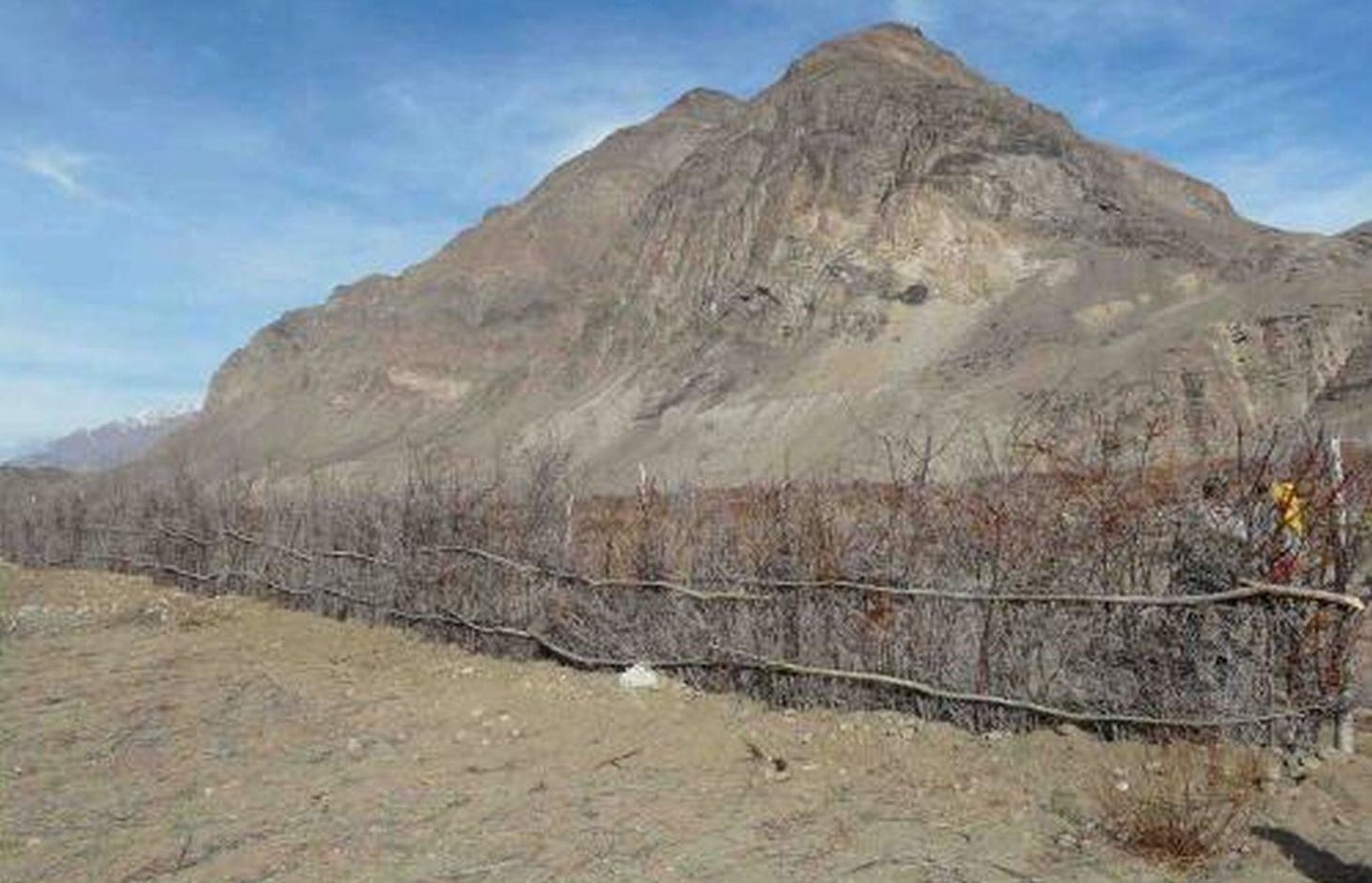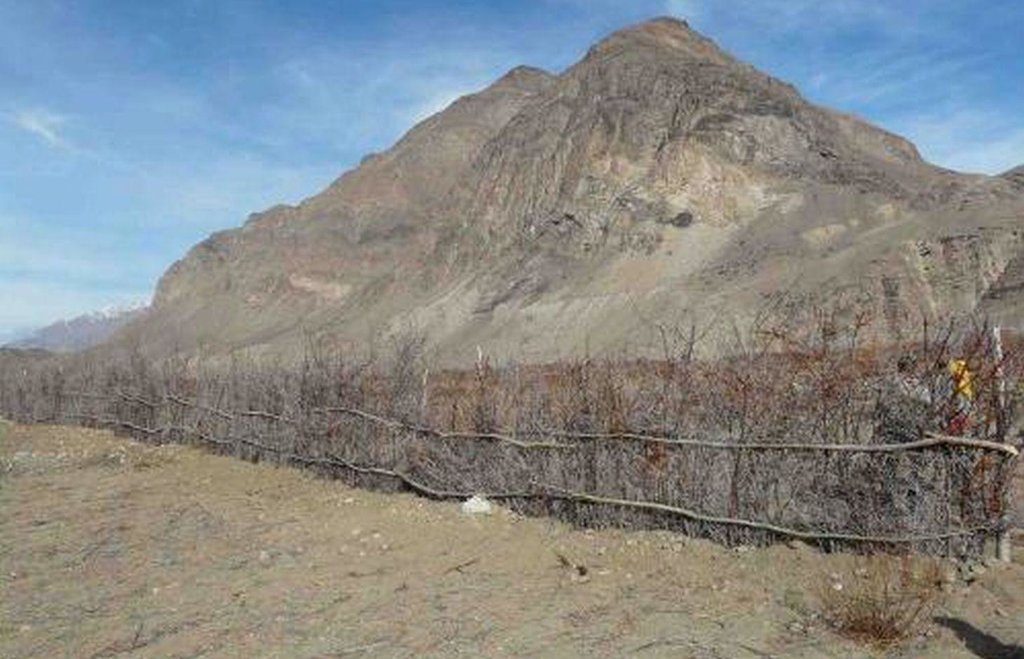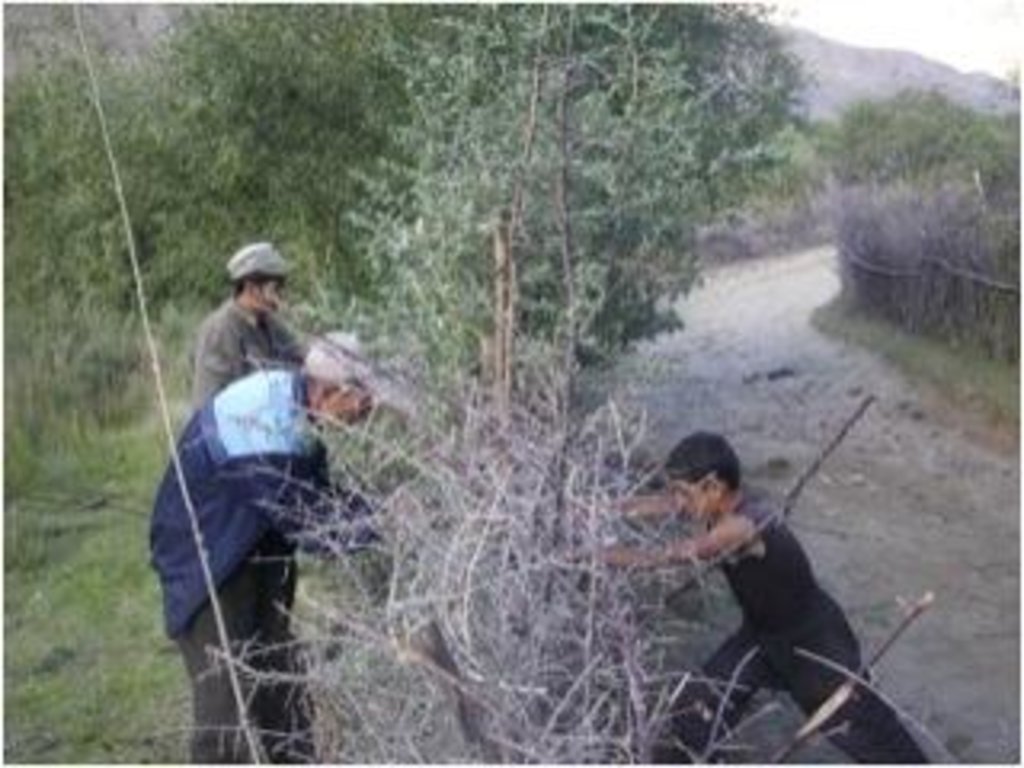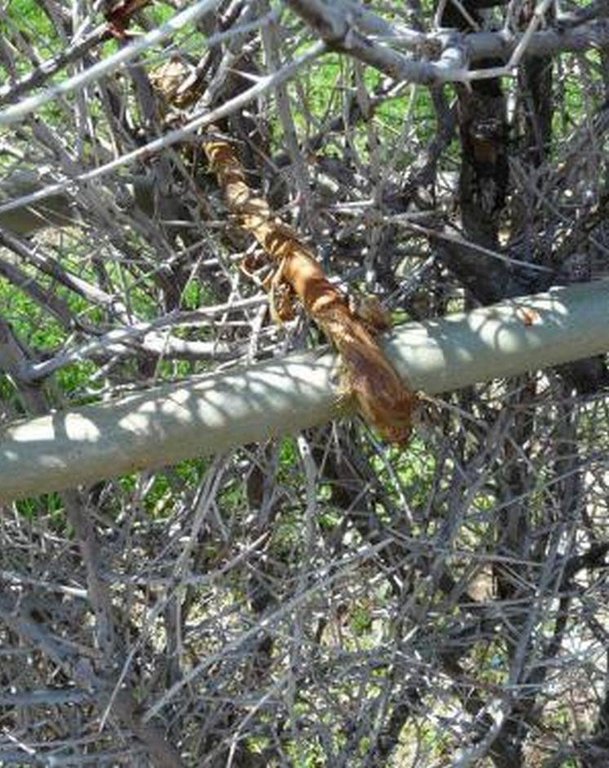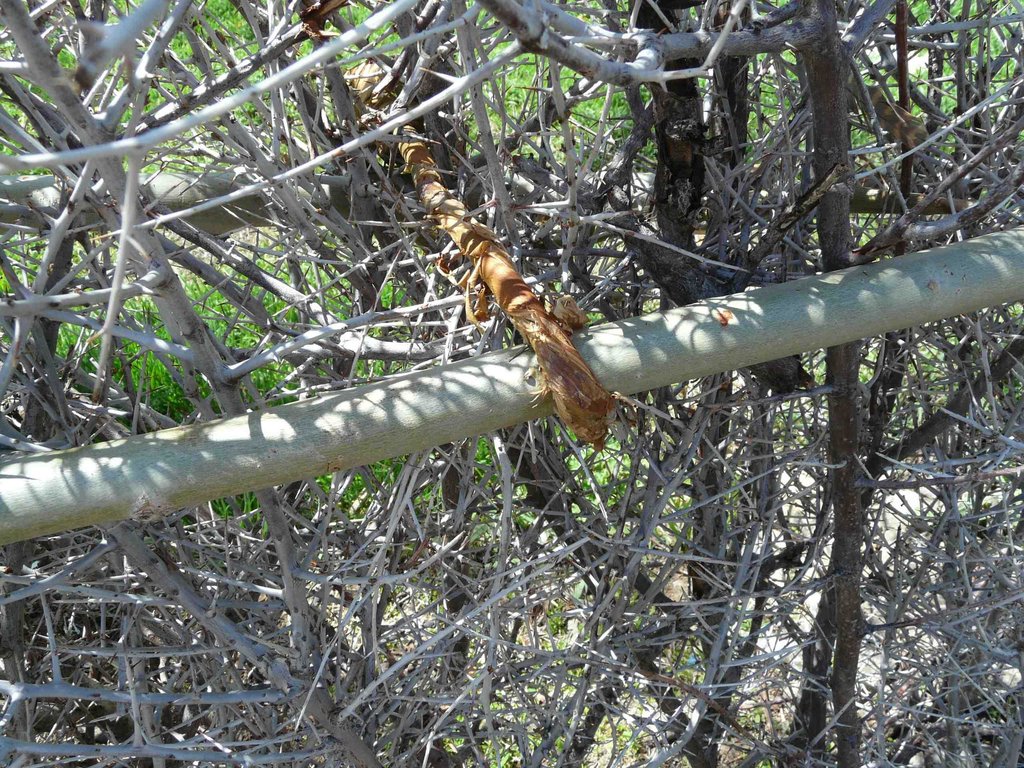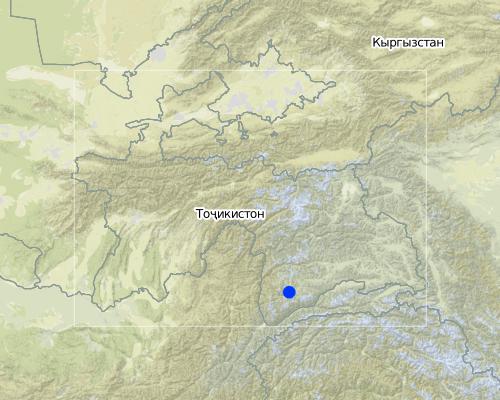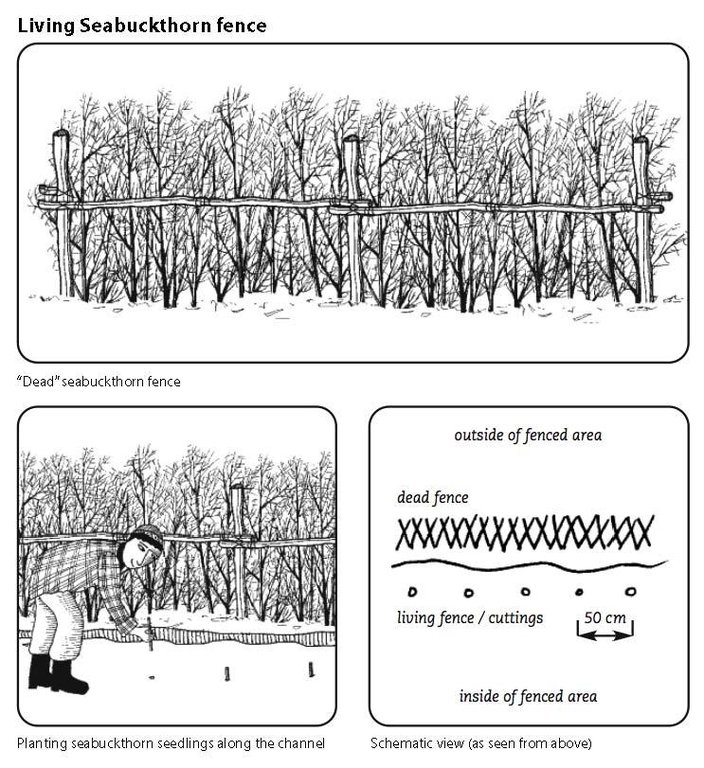Establishment of living seabuckthorn fences for the protection of reforestation sites (CACILM) [Tayikistán]
- Creación:
- Actualización:
- Compilador: Roziya Kirgizbekova
- Editor: –
- Revisor: Alexandra Gavilano
technologies_1036 - Tayikistán
- Resumen completo en PDF
- Resumen completo en PDF para imprimir
- Resumen completo en el navegador
- Resumen completo (sin formato)
- Establishment of living seabuckthorn fences for the protection of reforestation sites (CACILM): 27 de diciembre de 2016 (inactive)
- Establishment of living seabuckthorn fences for the protection of reforestation sites (CACILM): 2 de junio de 2017 (inactive)
- Establishment of living seabuckthorn fences for the protection of reforestation sites (CACILM): 22 de julio de 2017 (inactive)
- Establishment of living seabuckthorn fences for the protection of reforestation sites (CACILM): 14 de agosto de 2019 (public)
Visualizar secciones
Expandir todo Colapsar todos1. Información general
1.2 Detalles de contacto de las personas de referencia e instituciones involucradas en la evaluación y la documentación de la Tecnología
Persona(s) de referencia clave
Especialista MST:
Angermann Michael
+992 935 747318
michael.angermann@giz.de
Deutsche Gesellschaft für Internationale Zusammenarbeit (GIZ) GmbH,
Sustainable Management of Natural Resources in Gorno-Badakhshan, Okhonjon Str. 58-1, 736000 Khorog, Tajikistan,
Tayikistán
Especialista MST:
Neusel Benjamin
+992 935 747312
benjamin.neusel@cimonline.de
Deutsche Gesellschaft für Internationale Zusammenarbeit (GIZ) GmbH,
Sustainable Management of Natural Resources in Gorno-Badakhshan, Okhonjon Str. 58-1, 736000 Khorog, Tajikistan,
Tayikistán
Especialista MST:
Kirchhoff Joachim F.
+992 44 6006702
joachim.kirchhoff@giz.de
GIZ GmbH,
Regional Program on Sustainable Use of Natural Resources in Central Asia, Ayni Str./Nazarshoev Str., 734026 Dushanbe, Tajikistan
Nombre del proyecto que financió la documentación/ evaluación de la Tecnología (si fuera relevante)
Central Asian Countries Initiative for Land Management (CACILM I)Nombre de la(s) institución(es) que facilitaron la documentación/ evaluación de la Tecnología (si fuera relevante)
Deutsche Gesellschaft für Internationale Zusammenarbeit (GIZ) GmbH (GIZ) - Alemania1.3 Condiciones referidas al uso de datos documentados mediante WOCAT
¿Cuándo se compilaron los datos (en el campo)?
03/05/2011
El compilador y la/s persona(s) de referencia claves aceptan las condiciones acerca del uso de los datos documentados mediante WOCAT:
Sí
2. Descripción de la Tecnología MST
2.1 Breve descripción de la Tecnología
Definición de la Tecnología:
Protection of reforestation sites (willow, poplar and fruit trees) through living seabuckthorn perimeter fencing on Joint Forestry Management plots.
2.2 Descripción detallada de la Tecnología
Descripción:
In the heavily degraded flood plain forests of the Pamirs in eastern Tajikistan, living fences made out of seabuckthorn are protecting reforestation and Joint Forestry Management (JFM) sites. A living seabuckthorn fence consists of two layers. The outer layer is an instant fence made of thorny seabuсkthorn branches. The purpose of the outer layer is to immediately restrict animal and human access to the reafforestation site. The outer layer also buffers the inner layer of seabuckthorn, which is planted from seabuckthorn seedlings. The inner layer will establish itself over a number of seasons, eventually growing to a height of 1.5-2m. Once established, the seabuckthorn bush provides a low cost sustainable perimeter fence to protect reforestation activities. The bush also produces fruits for processing (in the frame of CACILM)
Purpose of the Technology: The purpose of this technology is to improve heavily degraded forest areas and establish new areas by restricting open access to the human population and preventing uncontrolled livestock grazing. As part of the Joint Forestry Management approach, these reforested areas are leased to the land user providing long-term legal control, as well as income opportunities for the tenants and the State Forestry Agency.
Establishment / maintenance activities and inputs: As part of the Joint Forestry Management approach (TAJ015), land is allocated by the State Forestry Agency to a designated land user. Once the size of the plot is established, a solid fence constructed of off-cuts of seabuckthorn and supported by willow poles is established around the perimeter of the JFM reforestation area. The seabuckthorn branches are fixed together with willow twigs, willow branches or wire and are attached to wooden poles. Once completed, seabuckthorn seedlings are planted at 0.5m intervals along a small irrigation channel on the inner side of the perimeter fence. After a few seasons these seedlings will grow into a natural living fence, which will take over the protection role from the perimeter fence constructed from off-cuts. The reforestion area is planted with branches of willow and poplar and interspersed with fruit trees. Reforestation planting materials are readily available in most parts of GBAO, and the Forestry Agency facilitates free access to seabuckthorn branches, willow branches and wooden poles. If required, wire and tools are provided by the JFM project.
Natural / human environment: The natural forest cover and biological diversity in many areas of GBAO has been significantly degraded. While population density in GBAO is low, natural resources are scarce due to the high altitude mountain environment and the pressure on these resources is great. In Soviet times, the Pamir region was highly dependent on subsidized coal from other parts of the Soviet Union. After independence, coal was no longer available and other fuel had to be sourced. Population pressure, poverty, and the lack of established local level institutions to manage forest lands have rendered forest areas an open access resource where the local population harvests forest products and grazes livestock without regulation. The local Forestry Agencies do not have the capacity to control overuse or to implement sustainable forestry management. As a part of the Joint Forestry Management approach (TAJ015) this SLM technology is a reintroduction of a traditional method for the protection of reforestation sites against livestock and, additionally, it clearly demarcates forest plot ownership and boundaries.
2.3 Fotografías de la Tecnología
2.5 País/ región/ lugares donde la Tecnología fue aplicada y que se hallan comprendidos por esta evaluación
País:
Tayikistán
Región/ Estado/ Provincia:
Tajikistan, Gorno Badakhshan Autonomous Region (GBAO)
Especifique más el lugar :
Ishkashim, Roshtkala and Shugnan Districts
Map
×2.6 Fecha de la implementación
Si no se conoce el año preciso, indique la fecha aproximada:
- hace menos de 10 años (recientemente)
2.7 Introducción de la Tecnología
Especifique cómo se introdujo la Tecnología:
- mediante proyectos/ intervenciones externas
Comentarios (tipo de proyecto, etc.):
Living seabuckthorn fencing is a traditional/indigenous method used for many years in the Pamirs. This technology has more recently been promoted by the project for the protection of forest plots under JFM. Similarly, the tree planting techniques used also follow traditionally applied methods in the Pamirs.
3. Clasificación de la Tecnología MST
3.2 Tipo(s) actuales de uso de la tierra donde se aplica la Tecnología

Bosques
Bosques/ zonas boscosas (semi) naturales:
- Tala selectiva
- plantation forestry
Productos y servicios:
- Madera
- Leña
- Frutos y nueces
- Otros productos forestales
- Conservación/ Protección de la naturaleza
- Protección contra desastres naturales
Comentarios:
Major land use problems (compiler’s opinion): Open access to forests leads to illegal use and destruction of forests; grazing of livestock within forest areas hinder regeneration of forests.
Major land use problems (land users’ perception): Shortage of fuel wood for cooking and heating; lack of pastures and fodder for maintaining or increasing livestock herds; land degradation and increasing vulnerability to natural hazard periods
Selective felling of (semi-) natural forests: Yes
Plantation forestry: Yes
Problems / comments regarding forest use: For now most of the forest plots are strongly degraded natural and formerly forested areas. So far felling is strongly restricted and permitted only where afforestation is conducted.
Forest products and services: timber, fuelwood, fruits and nuts, other forest products / uses (honey, medical, etc.), nature conservation / protection, protection against natural hazards
Future (final) land use (after implementation of SLM Technology): Forests / woodlands: Fp: Plantations, afforestations
Si el uso de la tierra ha cambiado debido a la implementación de la Tecnología, indique el uso de la tierra antes de la implementación de la Tecnología.
Mixed: Ms: Silvo-pastoralism
3.3 Información adicional sobre el uso de tierras
Número de temporadas de cultivo por año:
- 1
Especifique:
Longest growing period in days: 100Longest growing period from month to month: May to July
3.5 Difusión de la Tecnología
Comentarios:
Total area covered by the SLM Technology is 20 m2.
3.6 Medidas MST que componen la Tecnología

medidas vegetativas
- V1: Cubierta de árboles y arbustos

medidas de manejo
- M5: Control/ cambio de composición de las especies
Comentarios:
Main measures: vegetative measures
Secondary measures: management measures
Type of vegetative measures: aligned: -along boundary
3.7 Principales tipos de degradación de la tierra encarados con la Tecnología

erosión de suelos por viento
- Et: pérdida de capa arable
- Eo; efectos de degradación fuera del sitio:

degradación biológica
- Bc: reducción de la cobertura vegetal del suelo
- Bh: pérdida de hábitats
Comentarios:
Main causes of degradation: deforestation / removal of natural vegetation (incl. forest fires), over-exploitation of vegetation for domestic use, land tenure, governance / institutional (Lack of human and material resources of Forest Agency)
Secondary causes of degradation: overgrazing, population pressure, poverty / wealth, war and conflicts (Lack of energy resources during civil war)
3.8 Prevención, reducción o restauración de la degradación de la tierra
Comentarios:
Main goals: rehabilitation / reclamation of denuded land
Secondary goals: prevention of land degradation, mitigation / reduction of land degradation
4. Especificaciones técnicas, actividades de implementación, insumos y costos
4.1 Dibujo técnico de la Tecnología
4.2 Especificaciones técnicas/ explicaciones del dibujo técnico
Living seabuckthorn fence: The dead part of the fence prevents livestock from entering the forest plot, while in the long run the planted seedlings take over this role by forming a dense living seabuckthorn barrier.
Location: -. Gorno Badakhshan, Tajikistan
Date: February 2011
Technical knowledge required for field staff / advisors: low
Technical knowledge required for land users: moderate (It is not a difficult technology to implement.)
Main technical functions: improvement of ground cover, stabilisation of soil (eg by tree roots against land slides), increase of biomass (quantity)
Secondary technical functions: increase / maintain water stored in soil, water harvesting / increase water supply, water spreading, reduction in wind speed, promotion of vegetation species and varieties (quality, eg palatable fodder)
Aligned: -along boundary
Vegetative material: T : trees / shrubs
Number of plants per (ha): 400-800
Vertical interval within rows / strips / blocks (m): 0.5
Trees/ shrubs species: seabuckthorn (Hippophae rhamnoides)
Change of land use type: Enclosure of the plot, change from grazing to forest
Change of land use practices / intensity level: Change from open access to controlled access (fence)
Control / change of species composition
4.3 Información general sobre el cálculo de insumos y costos
otra / moneda nacional (especifique):
Tajik Somoni
Indique la tasa de cambio de USD a la moneda local (si fuese relevante): 1 USD =:
4,5
Indique el costo promedio del salario de trabajo contratado por día:
7.00
4.4 Actividades de establecimiento
| Actividad | Tipo de medida | Momento | |
|---|---|---|---|
| 1. | Establishment of living seabuckthorn fence | Vegetativas | Any time |
| 2. | Planting of poplar and willows | Vegetativas | early spring |
| 3. | Planting of fruit trees | Vegetativas | early spring |
4.5 Costos e insumos necesarios para el establecimiento
| Especifique insumo | Unidad | Cantidad | Costos por unidad | Costos totales por insumo | % de los costos cubiertos por los usuarios de las tierras | |
|---|---|---|---|---|---|---|
| Mano de obra | labour light | ha | 1,0 | 1352,0 | 1352,0 | 100,0 |
| Mano de obra | wire | m | 1,0 | 111,0 | 111,0 | 100,0 |
| Equipo | tools | pc | 1,0 | 22,0 | 22,0 | |
| Material para plantas | seedlings | pc | 1,0 | 766,5 | 766,5 | |
| Material para plantas | wood | cub/m | 1,0 | 801,0 | 801,0 | |
| Costos totales para establecer la Tecnología | 3052,5 | |||||
Comentarios:
Duration of establishment phase: 1 month(s)
4.6 Actividades de establecimiento/ recurrentes
| Actividad | Tipo de medida | Momento/ frequencia | |
|---|---|---|---|
| 1. | Fence repair | Vegetativas | spring, annually |
| 2. | Plant tending | Vegetativas | spring, annually |
4.7 Costos e insumos necesarios para actividades de mantenimiento/ recurrentes (por año)
| Especifique insumo | Unidad | Cantidad | Costos por unidad | Costos totales por insumo | % de los costos cubiertos por los usuarios de las tierras | |
|---|---|---|---|---|---|---|
| Mano de obra | labour medium | person/day | 3,0 | 20,0 | 60,0 | 100,0 |
| Mano de obra | wire | m | 1000,0 | 1,0 | 1000,0 | |
| Equipo | tools | pc | 2,0 | 11,0 | 22,0 | 100,0 |
| Material para plantas | wood | cub/m | 2,0 | 8,9 | 17,8 | 100,0 |
| Indique los costos totales para mantenecer la Tecnología | 1099,8 | |||||
Comentarios:
Machinery/ tools: Spades, scissors, picks, gloves, planting bars.
The costs were calculated for 1000m of live seabuckthorn fence and approximately 1ha of tree planting, including 50 fruit trees and 1200 poplars and willows. Costs were calculated in April 2011. It is assumed that seabuckthorn and wood for poles are readily available on the forest plot or can be provided by the State Forestry Agency from nearby plots. Seedlings needed for the live part of the fence are very small parts of seabuckthorn plants, which are available as well wherever seabuckthorn grows. Tools are provided through the Joint Forestry Management project for the period they are needed for construction and maintenance. The mentioned enrichment plantings do not apply to every plot to the same extent. These also highly depend on the motivation and interest of the tenant.
4.8 Factores más determinantes que afectan los costos:
Describa los factores más determinantes que afectan los costos:
The seabuckthorn seedlings are readily available in the area of implementation and incur no financial cost to the forest tenant. The labour is provided by the forest tenant. Labour is potentially a major expense if the land user must pay for it. Factors that contribute to the amount of labour required include the distance the seabuckthorn wood and seedlings have to be transported and the soil texture for the digging of a trench for the erection of the fence.
So far, the material needed for fencing and tree planting has been provided free of charge by the Forestry Agency. The only financial cost to the land user is the cost of the fruit trees, approximately 5 som per sapling. The land is provided by the Forestry Agency free of charge, however percentages of harvested forest products have to be paid to the Forestry Agency as the land owner's share.
5. Entorno natural y humano
5.1 Clima
Lluvia anual
- < 250 mm
- 251-500 mm
- 501-750 mm
- 751-1,000 mm
- 1,001-1,500 mm
- 1,501-2,000 mm
- 2,001-3,000 mm
- 3,001-4,000 mm
- > 4,000 mm
Especificaciones/ comentarios sobre la cantidad de lluvia:
Spring and autumn are (moderate) rainy seasons, summer is a dry period of min. 3 months
Zona agroclimática
- árida
Thermal climate class: temperate. continental climate, cold winters but warm, rather long summers
5.2 Topografía
Pendientes en promedio:
- plana (0-2 %)
- ligera (3-5%)
- moderada (6-10%)
- ondulada (11-15%)
- accidentada (16-30%)
- empinada (31-60%)
- muy empinada (>60%)
Formaciones telúricas:
- meseta/ planicies
- cordilleras
- laderas montañosas
- laderas de cerro
- pies de monte
- fondo del valle
Zona altitudinal:
- 0-100 m s.n.m.
- 101-500 m s.n.m.
- 501-1,000 m s.n.m
- 1,001-1,500 m s.n.m
- 1,501-2,000 m s.n.m
- 2,001-2,500 m s.n.m
- 2,501-3,000 m s.n.m
- 3,001-4,000 m s.n.m
- > 4,000 m s.n.m
Indique si la Tecnología se aplica específicamente en:
- situaciones convexas
Comentarios y especificaciones adicionales sobre topografía :
Footslopes only where there is sufficient water coming from the gorges. Flood plain forests in the valley floors (convex). Flood plain forests in valley floors, flat areas.
5.3 Suelos
Profundidad promedio del suelo:
- muy superficial (0-20 cm)
- superficial (21-50 cm)
- moderadamente profunda (51-80 cm)
- profunda (81-120 cm)
- muy profunda (>120 cm)
Textura del suelo (capa arable):
- áspera/ ligera (arenosa)
Materia orgánica de capa arable:
- baja (<1%)
5.4 Disponibilidad y calidad de agua
Agua subterránea:
< 5 m
Disponibilidad de aguas superficiales:
mediana
Calidad de agua (sin tratar):
agua potable de buena calidad
¿La salinidad del agua es un problema?
No
5.5 Biodiversidad
Diversidad de especies:
- mediana
5.6 Las características de los usuarios de la tierra que aplican la Tecnología
Orientación del mercado del sistema de producción:
- subsistencia (autoprovisionamiento)
- mixta (subsistencia/ comercial)
Ingresos no agrarios:
- > 50% de todo el ingreso
Nivel relativo de riqueza:
- pobre
Individuos o grupos:
- individual/ doméstico
Género:
- hombres
Indique otras características relevantes de los usuarios de las tierras:
Land users applying the Technology are mainly common / average land users
Difference in the involvement of women and men: Women are encouraged to participate, but as the work consists in rather strenuous forestry work, it is mainly applied by men.
Population density: < 10 persons/km2
Annual population growth: 1% - 2%
10% of the land users are average wealthy.
80% of the land users are poor (mostly villagers with no formal employment).
10% of the land users are poor.
Off-farm income specification: Mostly subsistence farming. Income mainly from remittances and formal employment.
5.7 Área promedio de la tierra que pertenece a o es arrendada por usuarios de tierra que aplican la Tecnología
- < 0.5 ha
- 0.5-1 ha
- 1-2 ha
- 2-5 ha
- 5-15 ha
- 15-50 ha
- 50-100 ha
- 100-500 ha
- 500-1,000 ha
- 1,000-10,000 ha
- > 10,000 ha
¿Esto se considera de pequeña, mediana o gran escala (refiriéndose al contexto local)?
- pequeña escala
Comentarios:
Average area of land owned or leased by land users applying the Technology: 0.5-1 ha, 1-2 ha, 2-5 ha, 5-15 ha
5.8 Tenencia de tierra, uso de tierra y derechos de uso de agua
Tenencia de tierra:
- estado
Derechos de uso de tierra:
- arrendamiento
Derechos de uso de agua:
- comunitarios (organizado)
Comentarios:
Forest plots of the State Forestry Agency are leased to local forest tenants according to the procedure described in the approach TAJ015 "Joint Forestry Management". Therefore the tenants hold 20-years management and user rights specified in the contract for the leased plots. The technology is applied on these forest plots leased by the State Forestry Agency. Water use rights are strictly regulated on a communal basis, whereas use rights for forest plots have to be negotiated on a communal basis as well.
5.9 Acceso a servicios e infraestructura
salud:
- pobre
- moderado
- bueno
educación:
- pobre
- moderado
- bueno
asistencia técnica:
- pobre
- moderado
- bueno
empleo (ej. fuera de la granja):
- pobre
- moderado
- bueno
mercados:
- pobre
- moderado
- bueno
energía:
- pobre
- moderado
- bueno
caminos y transporte:
- pobre
- moderado
- bueno
agua potable y saneamiento:
- pobre
- moderado
- bueno
servicios financieros:
- pobre
- moderado
- bueno
6. Impactos y comentarios para concluir
6.1 Impactos in situ demostrados por la Tecnología
Impactos socioeconómicos
Producción
producción de forraje
producción de madera
Cantidad luego de MST:
2-10m3
Comentarios/ especifique:
Before: illegal open access
diversidad de producto
Comentarios/ especifique:
non-timber forest products
generación de energía
Disponibilidad y calidad de agua
disponibilidad de agua para irrigar
Ingreso y costos
diversidad de fuentes de ingreso
Impactos socioculturales
seguridad alimentaria/ autosuficiencia
situación de salud
MST/ conocimiento de la degradación de la tierra
situación de grupos en desventaja social y económica
Impactos ecológicos
Ciclo de agua/ escurrimiento de sedimento
escurrimiento superficial
Suelo
humedad del suelo
cubierta del suelo
pérdida de suelo
Biodiversidad: vegetación, animales
biomasa/ sobre suelo C
diversidad vegetal
diversidad de hábitats
Reducción de riesgos de desastres y riesgos climáticos
velocidad de viento
6.2 Impactos fuera del sitio demostrados por la Tecnología
inundaciones río abajo
sedimentos transportados por el viento
6.3 Exposición y sensibilidad de la Tecnología al cambio climático gradual y a extremos relacionados al clima/ desastres (desde la percepción de los usuarios de tierras)
Cambio climático gradual
Cambio climático gradual
| Estación | tipo de cambios climáticos/ climas extremos | ¿Cómo es que la tecnología soporta esto? | |
|---|---|---|---|
| temperatura anual | incrementó | bien |
Extremos (desastres) relacionados al clima
Desastres climatológicos:
| ¿Cómo es que la tecnología soporta esto? | |
|---|---|
| tormenta de lluvia local | no muy bien |
| tormenta de viento | bien |
Desastres climatológicos
| ¿Cómo es que la tecnología soporta esto? | |
|---|---|
| sequía | no muy bien |
Desastres hidrológicos
| ¿Cómo es que la tecnología soporta esto? | |
|---|---|
| inundación general (río) | no muy bien |
Otras consecuencias relacionadas al clima
Otras consecuencias relacionadas al clima
| ¿Cómo es que la tecnología soporta esto? | |
|---|---|
| periodo reducido de crecimiento | no muy bien |
6.4 Análisis costo-beneficio
¿Cómo se comparan los beneficios con los costos de establecimiento (desde la perspectiva de los usuarios de tierra)?
Ingresos a corto plazo:
ligeramente negativo
Ingresos a largo plazo:
positivo
¿Cómo se comparan los beneficios con los costos de mantenimiento/ recurrentes (desde la perspectiva de los usuarios de tierra)?
Ingresos a corto plazo:
neutral/ balanceado
Ingresos a largo plazo:
positivo
6.5 Adopción de la Tecnología
- más de 50%
Si tiene la información disponible, cuantifique (número de hogares y/o área cubierta):
80% = 333 number of land user families / 85% of the area
De todos quienes adoptaron la Tecnología, ¿cuántos lo hicieron espontáneamente, es decir, sin recibir incentivos/ pagos materiales?
- 50-90%
Comentarios:
20% of land user families have adopted the Technology with external material support
83 land user families have adopted the Technology with external material support
Comments on acceptance with external material support: Material support was only provided where necessary inputs were not available but fencing nonetheless was crucial for the rehabilitation of the site.
80% of land user families have adopted the Technology without any external material support
333 land user families have adopted the Technology without any external material support
Comments on spontaneous adoption: For some forest areas a fence was established around the whole forest plot (not around each tenants individual plot), significantly reducing the workload as compared to the calculated costs.
There is a moderate trend towards spontaneous adoption of the Technology
6.7 Fuerzas/ ventajas/ oportunidades de la Tecnología
| Fuerzas/ ventajas/ oportunidades desde la perspectiva del usuario de la tierra |
|---|
|
Ownership for a demarcated forest plot. How can they be sustained / enhanced? Support trust in the ownership among tenants, effective collaboration with the Forestry Agency. |
|
Increased income opportunities if regeneration of forests is improved, and legal access to fuelwood for subsistence. How can they be sustained / enhanced? Support the establishment of marketing opportunities. |
|
Technology is easy to implement and non-available materials are provided. How can they be sustained / enhanced? Encourage building of living seabuckthorn fences and provide access to places where building materials are available. |
| Fuerzas/ ventajas/ oportunidades desde la perspectiva del compilador o de otra persona de referencia clave |
|---|
|
Use of locally available material and indigenous species, therefore low level of external input. How can they be sustained / enhanced? Support availability and spatial distribution of seabuckthorn for fencing, establish nurseries for seabuckthorn seedlings. |
|
Implementation and promotion of traditionally used technology. How can they be sustained / enhanced? Training to show advantages and sustainability of the traditional fencing technique. |
|
Effective protection of forest areas, protection of planted seedlings, support of natural regeneration. How can they be sustained / enhanced? Support the establishment of marketing opportunities for forest products and highlight the increased income and harvest opportunities if forests are protected and growing well. |
|
Sustainability through the planting of seabuckthorn seedlings and the evolution towards a living seabuckthorn fence. How can they be sustained / enhanced? Highlight the lower maintenance costs once the fence is naturally growing and dense. |
|
Potential for further processing of seabuckthorn. How can they be sustained / enhanced? Support the establishment of sustainable and market-oriented structures for seabuckthorn and other NTFP processing. |
6.8 Debilidades/ desventajas/ riesgos de la Tecnología y formas de sobreponerse a ellos
| Debilidades/ desventajas/ riesgos desde la perspectiva del usuario de la tierra | ¿Cómo sobreponerse a ellas? |
|---|---|
| Livestock cannot be grazed on forest areas. | Trainings and participatory discussions on opportunities to increase fodder and pasture availability, including "cut and carry" systems and increased production of perennial and other fodder crops within the forest plots. |
| High workload for fencing and planting. | Highlight the longterm income and subsistence opportunities when increased amounts of forest products can be harvested and support the creation of value chains and marketing options for forest products. |
| Debilidades/ desventajas/ riesgos desde la perspectiva del compilador o de otra persona de referencia clave | ¿Cómo sobreponerse a ellas? |
|---|---|
| Conflicts might arise within the village between the interest of protecting and supporting regeneration of the forest and the interest of villagers to graze their livestock on the forest plots. | Facilitation of integrated land management including forestry, pasture management and irrigation; facilitation of civil society organization formation. |
Vínculos y módulos
Expandir todo Colapsar todosVínculos
No hay vínculos
Módulos
No se hallaron módulos


